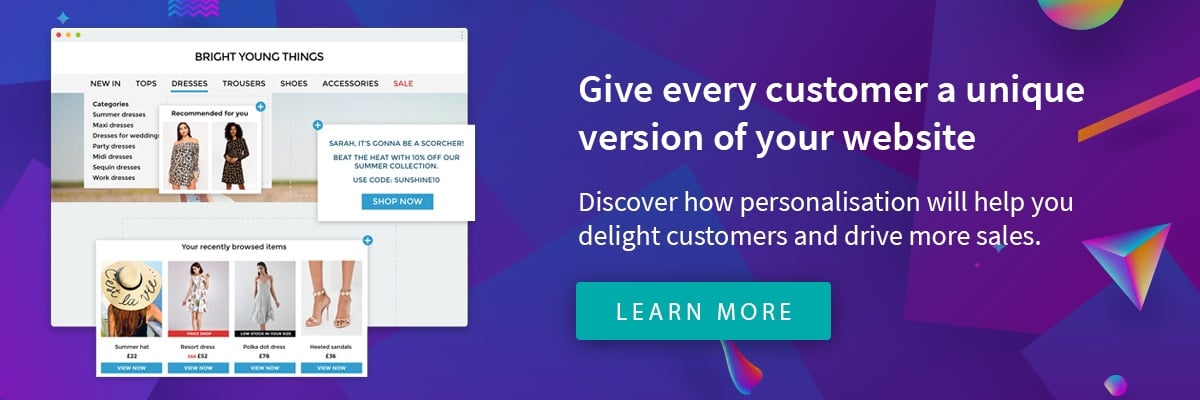Creating a personalised eCommerce experience isn’t just about making a good impression on the customer—it’s about generating more cold, hard cash.
Nearly 50 percent of consumers say they’ll spend more money with a brand that personalises their eCommerce experience. And it makes sense—shoppers save time and effort when a brand presents them with what they want, when they want it.
In this blog post, we take a look at eCommerce personalisation in the wild and explore the five types of personalisation you should be using to deliver a better customer experience and increase your sales.
1) Using customer details
It may sound obvious, but some eCommerce brands aren’t making the most of the customer details they have. Instead they’re firing out easy but anonymous one-size-fits-all email broadcasts. This can reduce click-through rates as the email content does not seem that relevant to the customer.
If this is something your brand is guilty of then consider using the customer’s name, age, or gender in your emails to make them more personal.
Using these basic details means you can make your marketing more relevant. By dropping in little snippets of information about the customer you are able to reinforce that you not only know who they are, but care about getting it right.
This personalised email from Netflix makes strong use of the customer’s name and recommends them a movie they might like.
2) Behavioural triggered emails
Behavioural personalisation is a quick win that covers everything from automated basket abandonment emails to lapsed customer win-back campaigns.
It’s a personalisation tactic that focuses on what the customer does, not who they are, and it never goes out of fashion. Unlike customer information (e.g. address or demographic information) that may become out of date, behavioural data is based on their very latest action meaning it’s always relevant and timely.
This behavioural triggered email from Nordstrom is highly personal, reminding the customer exactly what they just left in their shopping basket.
3) Product recommendations on your website
Some people assume we’re only talking about email when we ask them about their use of personalisation, but your web content can be personalised just like email can be.
Your homepage, product pages, and checkout can be personally curated for every visitor—tailored around their browsing and buying habits and making it more likely they’ll find and buy what they’re looking for.
Website personalisation is a great way to increase your conversion rates and give an end-to-end personalised customer experience from email to checkout.
Amazon is a leader when it comes to including personalised product recommendations on their website, as this example shows.
Read more: Learn the top customer experience trends to watch in 2018.
4) Personalised calls-to-action
Personalisation isn’t just about calling your customer by their first name—it can shape every aspect of your campaign.
Personalised calls-to-action can be tailored to the individual customer, their circumstances, buying patterns, and interests. And commercially they’re very successful: according to research they convert 42 percent better than unpersonalised, non-dynamic calls-to-action.
This personalised call-to-action on Very’s homepage uses the customer’s name to grab their attention.
5) Customer profiling
To take personalisation to the next level you need to join the dots. Customer profiling allows you to make recommendations based on what you think your customer might like.
Customer profiling is not just guesswork: it’s based on customer insight and algorithms that crunch data on the behaviour of similar customers. It’s an easy way to generate a prediction on what the customer might like or do next, even before they know it themselves.
This is easy to do with customer insight software such as PureIntelligence that lets you quickly profile, segment and spot trends in your customer data that you can use to make recommendations.
The example from Bustedtees below makes use of customer profiling to recommend T-shirts the customer might like.
Takeaway
If you’re currently using only the basics of personalisation in your eCommerce campaigns then there are plenty more opportunities out there for you to take advantage of.
With the right tools in place, you can put the five types of eCommerce personalisation we’ve explored into practice. Doing so will help you deliver a better online experience, prompt customers to buy more, and nurture your relationship with them.






